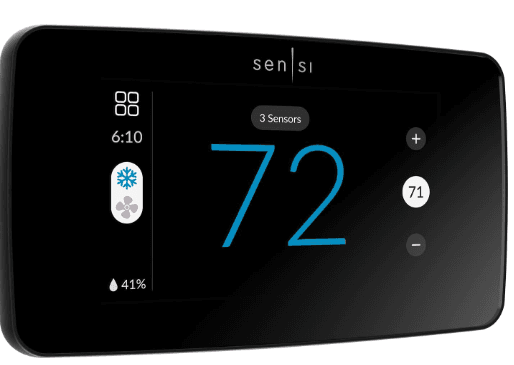Best Smart Thermostat for Energy Savings: Top Picks & Features in 2025
Tired of shocking electricity bills and a home that’s never quite the right temperature? You’re not alone. In today’s connected world, a smart thermostat is no longer a luxury—it’s an essential tool for any homeowner looking to slash energy costs and enhance comfort. These intelligent devices learn your family’s routines, adapt to the weather, and put complete control of your home’s climate right in the palm of your hand. But with a crowded market, how do you choose the one that will deliver the biggest savings?
As a home automation expert who has installed and tested countless smart devices, I’ve seen firsthand how the right thermostat can make a huge difference—both in your wallet and your daily comfort. This guide cuts through the noise. We’ll dive deep into how these devices work their magic, review the top energy-saving models on the market today, and give you the practical knowledge to choose the perfect smart thermostat for your home.
How Do Smart Thermostats Actually Save You Money?
Smart thermostats are far more than just digital versions of their manual predecessors. They are sophisticated, data-driven devices designed to eliminate energy waste from your home’s biggest energy consumer: the HVAC (Heating, Ventilation, and Air Conditioning) system. From my experience, the savings come from a combination of intelligent features working in harmony.
1. Adaptive Learning: Your Personal Energy Manager
This is the cornerstone of flagship models like the Google Nest. Instead of you programming a rigid schedule, these thermostats observe your behavior for the first week or so. They note when you wake up, when you leave for work, when you return, and your preferred sleeping temperature. From this data, they build a dynamic schedule that:
- Reduces energy use when you’re away: No more heating or cooling an empty house because you forgot to adjust the thermostat.
- Pre-conditions your home: It learns how long your home takes to heat or cool and starts the system just in time for you to arrive to a comfortable environment, avoiding long, energy-intensive run times.
- Adapts to change: If your schedule changes, the thermostat adapts without needing any manual reprogramming.
2. Geofencing: Smart Control Based on Your Location
Geofencing uses your smartphone’s GPS to create a virtual boundary around your home. When the last person with the app leaves this boundary, the thermostat automatically switches to an energy-saving “Away” mode. When the first person starts heading home and crosses back into the boundary, it automatically returns to your preferred “Home” setting. It’s a simple yet incredibly powerful way to ensure you never waste a dime on conditioning an empty home.
3. Detailed Energy Usage Reports: Knowledge is Power
Ever wonder how much your air conditioning ran last Tuesday? Most smart thermostats provide detailed reports via their app or a web portal. These reports show:
- Daily and monthly run times for both heating and cooling.
- Comparisons with previous months or even similar homes in your area.
- Personalized recommendations, like suggesting a 1-degree change to your schedule could save an estimated 5% on energy costs.
Reviewing these reports helped me identify that my AC was running excessively in the late afternoon. By closing the blinds on my west-facing windows, I saw a measurable drop in HVAC run time the very next week.
4. Integration with the Smart Home Ecosystem
Modern smart thermostats don’t operate in a vacuum. They integrate seamlessly with platforms like Amazon Alexa, Google Assistant, and Apple HomeKit. This unlocks powerful automations:
- Voice Control: “Hey Google, set the temperature to 72 degrees.”
- Automated Routines: Create a “Good Night” routine that turns off the lights, locks the doors, and sets the thermostat to your sleeping temperature with a single command.
- Occupancy Automation: Link your thermostat to smart lighting or motion sensors. If no motion is detected for 30 minutes in the main living area, the thermostat can automatically enter an eco-mode.
How to Choose the Right Smart Thermostat for Your Home
Before you jump to the top picks, it’s crucial to understand what features will benefit you most. Choosing the right device depends on your home’s HVAC system, your tech-savviness, and your budget.
HVAC System Compatibility (The C-Wire Question)
The single most important technical consideration is the “C-wire,” or “common wire.” This wire provides a continuous flow of 24V power from your furnace to the thermostat, which is necessary for power-hungry features like Wi-Fi and a backlit screen. Many older homes don’t have one.
- If you have a C-wire: Great! Almost any smart thermostat will work for you.
- If you don’t have a C-wire: You have options. Some thermostats (like Ecobee) come with a Power Extender Kit (PEK) that you can install at your furnace. Others are designed to work without one, though sometimes with reduced reliability. If you’re unsure, it’s often worth exploring models specifically designed for this scenario. That’s why considering the best battery-operated thermostats can be a viable alternative if running a new wire isn’t feasible.
Always use the manufacturer’s online compatibility checker before purchasing!
Key Features to Prioritize for Maximum Savings
- Learning Algorithms: If you want a “set it and forget it” experience, prioritize a thermostat with true machine learning, like the Nest.
- Remote Room Sensors: If your home has hot or cold spots, or if you want to prioritize the temperature of a specific room (like a baby’s nursery), a system with remote sensors (like Ecobee) is a game-changer.
- Geofencing: A must-have for people with unpredictable schedules. It’s the most foolproof way to save energy when you’re away.
- Smart Home Integration: Choose a thermostat that works with your preferred voice assistant (Alexa, Google, or Siri) for the most seamless experience.
The Best Smart Thermostats for Energy Savings in 2025
After extensive research and hands-on experience, these are the models that consistently deliver on their promise of energy efficiency and user-friendly operation.
1. Google Nest Learning Thermostat (4th Generation)

Best for “Set It and Forget It” Automation
The Nest Learning Thermostat remains the icon of the smart home world for a reason. Its primary strength is its powerful machine learning algorithm. You simply use it like a normal thermostat for a week, and it builds a remarkably accurate schedule for you. The signature “Nest Leaf” appears when you choose an energy-saving temperature, subtly guiding you toward better habits. It’s the perfect choice for users who want maximum savings with minimal effort.
Pros
- True learning algorithm adapts to your life
- Premium, intuitive design and interface
- Excellent energy reporting and guidance
- Broad smart home compatibility
Cons
- Higher price point
- Doesn’t include remote sensors
- Can be tricky to install without a C-wire
For a deeper dive into how it stacks up against competitors, our Honeywell Thermostat vs Nest comparison provides a detailed analysis.
Check Price on Amazon2. Ecobee Smart Thermostat Premium

Best for Homes with Uneven Temperatures
The Ecobee Smart Thermostat Premium tackles a problem the Nest doesn’t: temperature imbalances. It comes with a remote “SmartSensor” that measures both temperature and occupancy in a different room. You can tell the Ecobee to maintain the temperature based on the sensor in the living room during the day and the one in the bedroom at night. This “Follow Me” feature ensures comfort where you actually are, preventing the HVAC from overworking to heat or cool unused spaces. It also has Alexa built-in, acting as a smart speaker.
Pros
- Includes a remote sensor for zoned comfort
- Built-in Alexa and Siri compatibility
- Excellent app with granular controls
- Includes a Power Extender Kit for non-C-wire setups
Cons
- Doesn’t “learn” schedules in the same way Nest does
- Interface can be less intuitive than Nest’s
3. Honeywell Home T9 Smart Thermostat

Best for Multi-Room Control on a Budget
The Honeywell T9 brings the multi-room sensor technology of the Ecobee to a more accessible price point. The T9’s sensors are impressive, measuring temperature, humidity, and motion, and they have a much longer range than competitors. You can prioritize specific rooms or average the temperature across multiple active rooms. It’s a powerful and flexible system that excels at delivering customized comfort throughout your entire house without breaking the bank.
Pros
- Excellent multi-room sensor performance
- Reliable geofencing and scheduling
- Easy-to-use mobile app
- More affordable than top-tier competitors
Cons
- Requires a C-wire (no adapter included)
- The physical design is less premium than Nest or Ecobee
If you’re weighing your options, our Honeywell vs. Emerson Thermostats guide offers a comprehensive comparison of features and value.
Check Price on Amazon4. Emerson Sensi Touch Smart Thermostat

The Practical, No-Nonsense Choice
The Emerson Sensi Touch is a workhorse. It forgoes flashy features like learning algorithms for rock-solid fundamentals: flexible scheduling, geofencing, and extremely broad HVAC compatibility. It’s often lauded by HVAC professionals for its easy installation process and reliability. It’s an ENERGY STAR Partner of the Year award winner, proving its energy-saving credentials. If you want smart control without the complexity or high cost of a learning model, the Sensi is an outstanding choice.
Pros
- Very easy to install, often without a C-wire
- Straightforward and reliable app
- Energy Star certified for proven savings
- Great value for the price
Cons
- No learning capabilities
- Basic design and display
5. Amazon Smart Thermostat

Best Budget Option for Alexa Households
Developed with Honeywell Home technology, the Amazon Smart Thermostat is an incredible value for homes already invested in the Alexa ecosystem. It lacks a fancy screen or learning features on the device itself, but it leverages the power of Alexa for intelligent control. You can let Alexa manage the schedule for you through “Hunches,” which automatically adjust the temperature when it thinks you’re away or asleep. It’s an ENERGY STAR certified device at a price that’s almost impossible to beat.
Pros
- Extremely affordable price point
- Seamless integration with Amazon Alexa
- “Alexa Hunches” provide smart automation
- Clean, minimalist design
Cons
- Requires a C-wire
- Heavily reliant on the Alexa app and voice control
- No Google Assistant or Apple HomeKit support
Feature Comparison at a Glance
| Feature | Google Nest Learning | Ecobee Premium | Honeywell T9 | Emerson Sensi Touch | Amazon Smart Thermostat |
|---|---|---|---|---|---|
| Learning Schedule | ✔ | ✖ | ✖ | ✖ | (Via Alexa) |
| Geofencing | ✔ | ✔ | ✔ | ✔ | ✔ |
| Remote Sensors | ✖ (Sold Separately) | ✔ (1 Included) | ✔ (1 Included) | ✖ | ✖ |
| C-Wire Required | No (Recommended) | No (Adapter Included) | Yes | No (In most systems) | Yes |
| ENERGY STAR Certified | ✔ | ✔ | ✔ | ✔ | ✔ |
| Built-in Voice Assistant | ✖ | (Alexa & Siri) | ✖ | ✖ | ✖ |
Frequently Asked Questions (FAQs)
Which smart thermostat saves the most energy?
In my experience, the thermostats that save the most are the ones that best fit your lifestyle. For users with a consistent schedule, the Google Nest Learning Thermostat often yields the highest savings due to its self-optimizing schedule. For homes with multiple occupants and varied temperatures, the Ecobee Smart Thermostat excels by using its remote sensors to avoid heating or cooling empty rooms. Ultimately, any ENERGY STAR certified smart thermostat can save an average of 8-15% on your heating and cooling bills when used correctly.
How much money can you really save with a smart thermostat?
Savings vary based on climate, home insulation, and HVAC efficiency, but manufacturers and independent studies report average annual savings between $130 and $145. Google Nest, for example, states its thermostat saves an average of 10-12% on heating and 15% on cooling. The key is using the smart features—letting the schedule run, using eco modes, and taking advantage of geofencing.
Can I install a smart thermostat myself?
Yes, in most cases. If you have a modern HVAC system (and ideally a C-wire), installation is typically a 30-minute DIY project. It usually involves turning off power at the breaker, removing the old thermostat, labeling the wires, connecting them to the new base plate, and setting it up via the app. However, if you’re uncomfortable with wiring or have a complex system (like a dual-fuel heat pump), hiring a professional HVAC technician is always the safest bet.
Do smart thermostats work with heat pumps?
Absolutely. All the models recommended in this guide are fully compatible with most modern heat pump systems, including those with auxiliary or emergency heat strips. During setup, the app will guide you through configuring the thermostat specifically for your heat pump to ensure it operates efficiently, especially during the colder months when it needs to manage the switch to auxiliary heat correctly.
Final Thoughts: Is a Smart Thermostat Worth the Investment?
Investing in a smart thermostat is one of the most intelligent upgrades you can make to your home. It’s a rare purchase that enhances your daily comfort while actively paying for itself over time through energy savings. The key is to choose the device that aligns with your home’s needs and your personal preferences.
Whether you prefer the automated intelligence of the Google Nest, the room-by-room precision of the Ecobee, or the unbeatable value of the Amazon Smart Thermostat, you’re taking a significant step towards a more efficient, convenient, and eco-friendly home. Many people wonder, “Are wifi thermostats worth it?” Based on the tangible savings and improved quality of life, my answer is a resounding yes.



